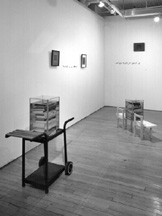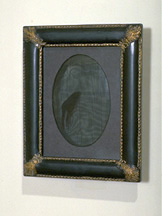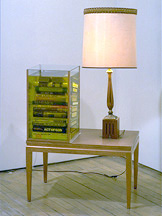- MAIN INDEX | ARTIST INDEX
| November 5 - December 22, 1994 Choi Yan-Chi
| |
 Choi Yan-Chi, installation view of "Drowned V", 1994. Photo Peter MacCallum. 18K | |
 Choi Yan-Chi, detail view including water and living Siamese fighting fish, 1994. Photo Peter MacCallum. 18K |  Choi Yan-Chi, detail view including vegetable oil and books on Western culture, 1994. Photo Peter MacCallum. 18K |
| Brochure Text: Drowned V - swimming in the dark I take it the preservers of ancient culture have read the classic in which it says, "Lin Hui abandoned jade worth a thousand gold pieces, but ran away carrying the child." This can hardly be considered the act of a beast. But what, pray, are those who abandon the child to carry off the jade.? --Lu Xun, Sudden Notions When Lu Xun wrote "Sudden Notions" in 1925, embalming the past already had a long history. The preservers of ancient culture meant to safeguard the past by placing monetary and cultural value on its products. But this kind of value does not engage the present with the past, rather, it petrifies the past as an unshakable value at the expense of living culture. If the phrases Cultural Revolution and Great Leap Forward suggest a break with the past and a commitment to the future, carrying off the child rather than the jade, this chasm in time was to create a new chapter of history responsible to living culture rather than the dead. As an artist from Hong Kong, Choi Yan-Chi has felt the pressure to preserve and work within the classical traditions of the cultural motherland. During my recent visit to her Toronto studio, she explained that water and ink painting, originating from northern mainland China and made palatable by modernism, is the Hong Kong cultural bureaucracy's chosen face. The two styles simply collide, and neither is thought through the practices of local, contemporary culture; the future is slapped onto the past and neither is thought through the other. The demand to sacrifice a thoughtful future for the continuation of the past has made Choi's work difficult. But she is also aware of the problems of sacrificing past culture for the sake of a better future--the history of twentieth-century China is filled with such evidence. Suspended between two states, between two relationships with the past, Choi is at home in neither. Her sense of suspension was exacerbated during the 1989 student movement in mainland China. She identified with the students' cause but felt the helplessness of physical and political distance. The series of works entitled "Drowned" was a response to this helplessness. In previous incarnations of the installation, poems about the Tiananmen Square massacre were cut up and left to undulate like fish in tanks filled with water. In Drowned II, Choi draws the Chinese government's definition of human rights as the right to sustenance as the amputation of a culture's thought and history. Drowned m places museological cases reminiscent of fish tanks on top of empire and regency style pedestals and tables. The cases contain stacks of books preserved in oil, but the books are inaccessible; they can be viewed, but their knowledge cannot be transmitted. Among the monumental cases is a form draped in a shroud. Underneath are bowls of goldfish which, according to Chinese superstition, deliver good feng shui, or positive qi. Drowned V transforms the high-stake political concerns of previous incarnations of the installation into a more private statement about domesticity and its relation to the past. Beige walls, mass-produced frames, decorative elements reminiscent of Victorian bric-a-brac, books, fish tanks, and the furniture of everyday middle-class North American life create a sense of home. But the details in the installation are inappropriate to domesticity and create within the tableaux a sense of restlessness that perhaps always resides within domestic life. Most of the furniture, circa 1950s to 1980s, has been altered. The frames on the wall contain not images of nature morte but a black gauze echoing the shroud in Drowned m. Behind this screen we glimpse the movement of fish--the gauze both obscures and reveals life. The cases of preserved books in oil render useless the everyday furniture they are supported by. The books, mostly bought from the public library, and the garage-sale furniture are cast-offs from our recent past. Like the books in Drowned III, we see only titles, and not the meaning behind them. Unlike Drowned m, where Choi raises the question of canonisation by placing the book-filled cases atop pedestals, the cases in Drowned V are placed on a chair seat, a barbecue, a television stand--they substitute for ourselves and the world we experience through our leisure activities. The sense of details gone wrong, of the uncanny in Drowned V, is due to compressing our desire for the new with our rejection of the past. Choi recovers and preserves those articles only recently desired and rejected by us in the course of our daily lives. The habits of immortalisation and forgetfulness, essentially two sides of the same coin, underlie our patterns of consumption and are shown as the essential deadening trajectory of North American middle-class life. But this trajectory is not escaped by a radical break with the past. The same oil that preserves and renders useless is flammable, and can erase the past from our view. Choi shows that to preserve the past to the point of inaccessibility, to forget it as if it were a fashion, and destroy it for the sake of the future are all failed attempts to engage with history.
In the a "Drowned" cycle, Choi questions the solidity of the past and refigures the ground for memory. The contexts for these memories --cultural history, revolutionary politics, colonialism, and North American consumerism--engage the past with the present and future. In pointing out the false choice between the jade and the child, between the past and the future, Choi poses the possibility of abandoning neither.
| |